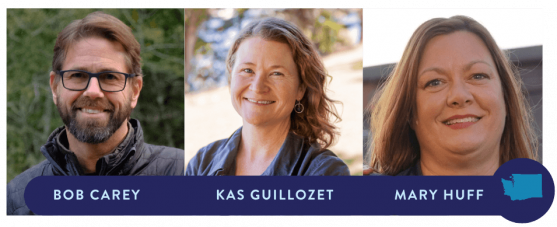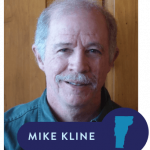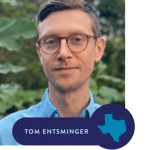Lessons from the Network: Floodplains by Design
 This interview compiles a combination of voices: Bob Carey, The Nature Conservancy of Washington; Kas Guillozet, Bonneville Environmental Foundation; Mary Huff, Washington Department of Ecology. It has been lightly edited for clarity.
This interview compiles a combination of voices: Bob Carey, The Nature Conservancy of Washington; Kas Guillozet, Bonneville Environmental Foundation; Mary Huff, Washington Department of Ecology. It has been lightly edited for clarity.
River Network (RN): To get started, can you give me a brief introduction to who you are and your role at your organization?
Bob Carey (BC): I am Bob Carey, Strategic Partnership Director at The Nature Conservancy (TNC) in Washington, the main founder of Floodplains by Design. I was first hired on in Washington to lead our work in the Skagit River. That work transitioned to helping lead our water work in Puget Sound, which then led to the statewide Floodplains by Design (FbD) program. That program was initially Puget Sound focused. Now I have two foci: one is supporting other states that are interested in developing a large scale approach to river management systems change. The other is helping TNC develop a program in the Columbia River system.
Kas Guillozet (KG): I am Kas Guillozet, Bonneville Environmental Foundation’s Senior Director, Watersheds Program. I lead the NGO Backbone Team and oversee all aspects of our work and partnership.
Mary Huff (MH): I am Mary Huff, the Floodplain Unit Supervisor with the Washington Department of Ecology (Ecology). I am the day-to-day lead for Ecology on FbD activities. This means I plan and oversee our work with the NGO backbone, which includes supporting other Ecology policy, planning, and financial management staff who administer FbD at the program and project levels.
RN: What was the impetus to develop and implement FbD? Who and what were the primary drivers that resulted in FbD?
BC: We and others had been working on salmon recovery and river conservation for years and came to the realization that, even with all the money that was being devoted to salmon recovery in Washington state, we were never going to succeed because there was so much else happening in the watershed that was counter to conservation. We would do all these great habitat protection and restoration projects and then upstream we’d see more money being spent armoring the riverbank.
And there was opposition. We realized that we would always struggle to get enough support, particularly from the agricultural community, which didn’t want to lose any more farmland to salmon habitat restoration or development or whatever. We realized we weren’t going to win their support just doing projects that were focused on salmon. There was too much else that was happening in the watershed that was counter to what we were doing. We just came to the realization that, as a Western Culture, we have tried to manage these river systems, which provide fish, water, wildlife, recreation, flood waters, rich alluvial soils, and all these things that are interconnected and part of the system, in silos. It just doesn’t work. We had all these different programs and organizations focused on different things that were at odds with one another. The concept of FbD is to bring those different interests into the room and develop a more holistic vision and plan for the system that serves all those needs of the community.
RN: What organizations have you partnered and built effective coalitions with? What work did you do to build trust, designate roles and responsibilities, and successfully come together?
BC: Puget Sound Partnership (PSP) was our main initial partner. PSP is a state agency that’s charged with recovering and cleaning up the Puget Sound ecosystem. Others included NOAA Fisheries, EPA and USGS.
EPA and NOAA Fisheries¹ provided the initial funding to create the Floodplains by Design partnership. The partnership launched when that money came through in 2012. Prior to the launch, conversations about the Puget Sound recovery planning process took place with Puget Sound Partnership, TNC and other NGOs, Counties, Tribes, and others who were all trying to think about how we accomplish salmon recovery, scale up floodplain recovery, and fix this broken river management system. TNC led these conversations and played a critical role by infusing integrated floodplain management thinking. We also had a lot of other conversations with those involved in floodplain management such as flood control authorities, Tribes (who have a strong interest in and legal rights to salmon), environmental NGOs, farm groups, and conservation districts. All the major players were talking about what they were seeing on the ground and collectively, we came up with the idea that became Floodplains by Design. Ecology came to the table after we secured the first round of FbD project funding from the state legislature in 2013. As they were the state floodplain manager, they were the agency designated to manage this new funding source and have been a core partner over since.
RN: How did you successfully advocate for FbD to take hold? How long did it take? What strategies and tactics did you use? Where did support for the program/paradigm shift come from?
BC: Based on what we learned about how to advance river and estuary restoration in the Skagit River, we concluded that you can’t manage these integrated systems in silos. It doesn’t work.
The Puget Sound recovery planning conversations mentioned above were the springboard and led to support for the FbD paradigm shift. Initial funding sources were EPA and NOAA Fisheries.
At first, we focused on the science to show how flood risks lined up with salmon recovery. That focus didn’t work, however, because it was at the wrong scale without local decision makers and locally specific information at the table. It was a personal learning for me that science was not the barrier. Instead, siloing of programs was. In addition, Tribes need a seat in the floodplain management planning process.
RN: Was there opposition to FbD? Who was opposed? How was the opposition diffused/overcome?
BC: At the beginning, the agricultural community, who didn’t want to lose any more farmland to salmon restoration or development, was opposed. We didn’t just need to neutralize their opposition to salmon restoration, we needed to win their support. In north Puget Sound, we won the agricultural community’s support at 2 project sites by integrating both salmon restoration and the reduction of flood risks concurrently. There was a lot of learning in those projects that informed FbD.
RN: Developing a new program is a big accomplishment, but we know it isn’t the end of the story. Can you describe what implementation has looked like so far?
MH: Implementation is about current project funding, the functioning of the Backbone Team, and capacity building of the Network. In the 2023-2025 cycle, the program received $64.5 million for 11 projects that leveraged that state funding to bring in additional funding as much as sevenfold. Since its inception, the program has funded more than $280 million in projects that have reduced flood risk for 63 communities across the state while restoring over 70-miles of salmon habitat, increasing agricultural viability, and improving local economies.²
RN: Are you continuing to work with affected communities and/or state agencies to make sure FbD is actually being well implemented?
KG: Yes, through several means and we can always do better. One of our primary goals as a backbone partner is to bring “ease” into systems. We make this explicit because we regularly observe the tendency of bureaucracies to calcify around procedures that may no longer serve the system, of requirements to grow ever more cumbersome and systems to become bogged down by their own weight. We are continually touching base with network members to understand what is not working. We learn a lot from the creativity and grace of local implementing partners. The influx of federal funding has really shined a light on the need for process improvements that make the most of the capacity that exists and not let the system burn people out. People are the engine behind the work and systems change is hard.
One recent success has been the removal of a 20% match requirement for FbD grants. This occurred in a stepwise fashion, beginning with a waiver for tribal applicants and under resourced jurisdictions, and will now apply to all applicants moving forward, starting with the 2025-2027 biennium. This occurred thanks to the hard work of local implementers in demonstrating the tremendous administrative burden that a match placed on implementing these complex, integrated, long-term projects. The leverage was there, and the state was able to build a compelling case that garnered leadership support. We talk a lot about process improvement, and this often requires lifting from all parts of the network.
RN: What policy issues are a current priority for FbD? What kind of strategies are you using to advance your goals?
KG: Right now, permitting reform, addressing bottlenecks in buyouts and acquisitions, and ensuring that the work local collaboratives are doing to support climate resilience is seen, valued, and funded are our priorities.
We bring in brilliant partners like our Tribal liaison Bobby Whitener or collaboration consultant Carol MacIlroy to help us offer spaces for people to share ideas, scrutinize solutions, and develop shared tactics. We strive to listen deeply to those we aim to support and problem-solve with and try to create spaces for people to share their opinions—cognizant of power dynamics, personalities, risk, and ability to review complex materials. We know that not all input can happen in a group, and individual outreach and connection may be critical to getting the most important input. Because we are an integrated effort, when we are working with more than one distinct perspective (i.e., regional, federal and local, farm, fish, agency, nonprofit), attention needs to be given to various perspectives. Regional or federal experts do not become local experts or vice versa in the process. Different perspectives can ask very good questions as they aren’t constrained by having to manage all the details and nuance that can become limiting. At the same time, that does not make them experts. We strive to constantly check in on our own ego, orientation to power and privilege, and motivations. Lastly, we express gratitude for the inspiring people we get to work with every day.
RN: What aspect of your work, or accomplishment, are you most proud of?
BC: I like to think that my passion is based in the change that has happened because of FbD. Formerly antagonistic organizations are working together, and collaboratively doing bigger, better things that bring more benefits to the community and the ecosystem alike. So, this works, and I see a formerly ineffective floodplain management system changing in Washington in really positive ways.
KG: Honestly, I am most humbled by the time and expertise that the FbD network consistently offers up. Sometimes it can feel like our political and institutional systems set up every conceivable roadblock to getting this good work done. Communities relentlessly plan, work through hard things, and advance extremely complex visions. Individuals earn each other’s respect over time in the best cases, and people keep showing up even when things are really difficult because this work is so necessary and vital.
¹ National Oceanographic and Atmospheric Agency, National Marine Fisheries Service.
² Impact of the FbD Grant Program, reduced flood risk for 63 communities across the state while restoring over 70-miles of salmon habitat, increasing agricultural viability, and improving local economies. https://floodplainsbydesign.org/communities-in-action/impact/ (last visited 7/8/24)







